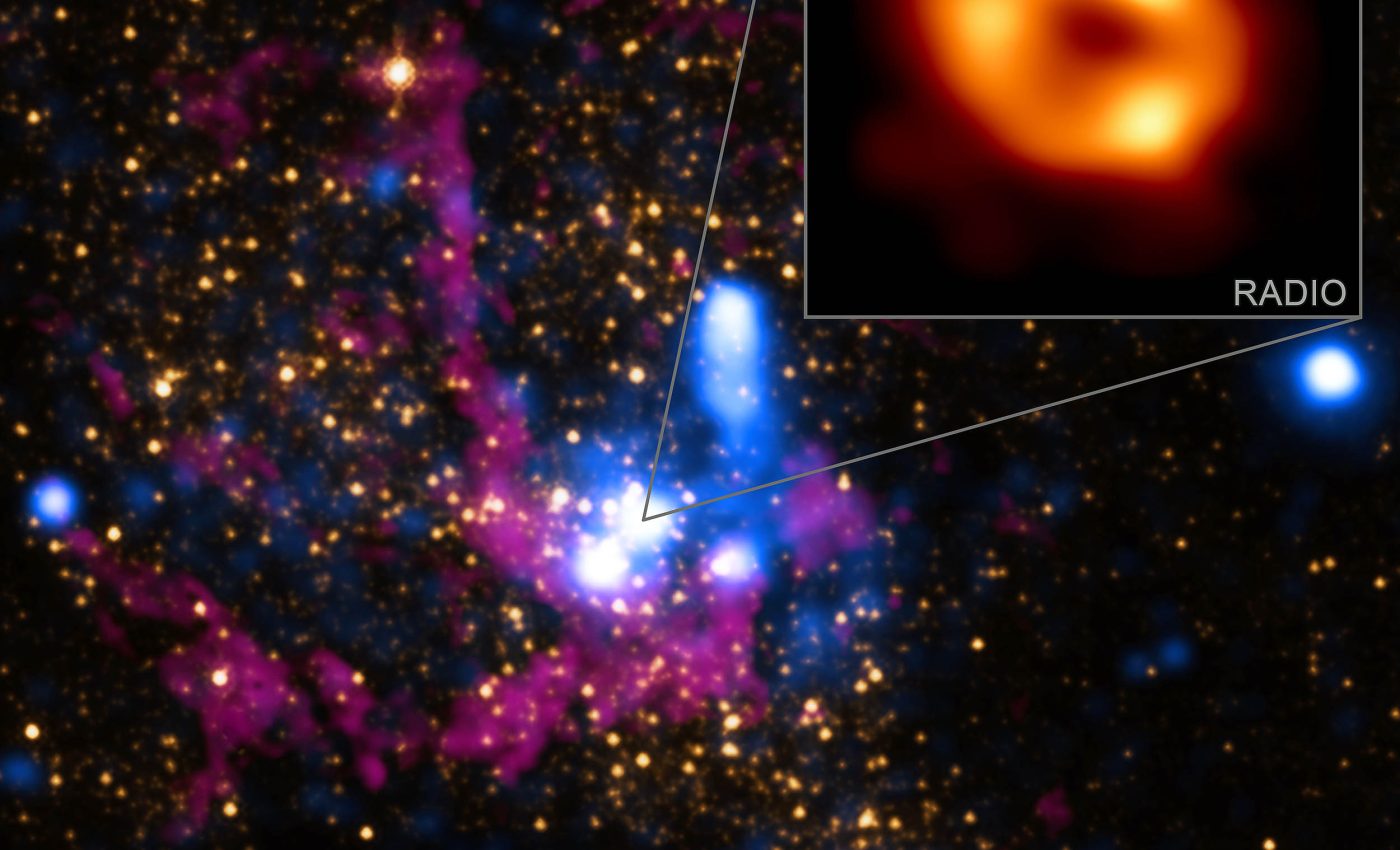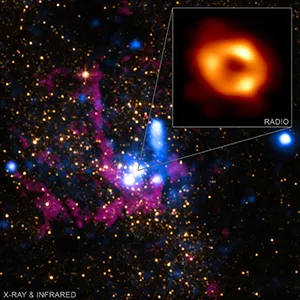
Hot wind seen blasting from the Milky Way's supermassive black hole for the first time
At the heart of our galaxy sits a supermassive black hole called Sagittarius A* (Sgr A*). In addition to swallowing all matter in their vicinity, black holes like Sgr A* can also blow powerful “winds” that push surrounding gas away and shape their cosmic neighborhoods.
Astronomers used a giant radio telescope array (ALMA) to make the deepest, sharpest map yet of the cold gas in the Sgr A* neighborhood.
In that map they spotted a big, cone-shaped gap surrounding the black hole – like a snowplow trail – where cold gas is missing and hot gas shows up instead.
That pattern is exactly what we’d expect if Sgr A* is currently blowing a hot wind that clears a path through the gas near the center of the Milky Way.
By mapping the innermost circumnuclear disc in extraordinary detail, the research team team led by Mark Gorski and Elena Murchikova at Northwestern University finally uncovered the long-predicted, never-seen Sgr A* wind.
Relatively quiet winds from Sgr A*
Compared with the blinding lighthouses at the centers of other galaxies, Sgr A* is famously demure. It doesn’t launch the towering, radio-bright jets we spot across the distant universe.
Even so, theory says supermassive black holes like Sgr A* should blast out hot winds – streams of heated gas that are kicked out from the maelstrom just outside the event horizon.
For our black hole, those winds had remained stubbornly elusive, in part because the central few light years are a packed tangle of stars, dust, and gas known as the circumnuclear disc.
Gorski and Murchikova, who were recently interviewed by New Scientist, stitched together five years of ALMA observations to build a map of cold gas within a few light-years of Sgr A* at roughly 100 times the sharpness of prior surveys.
They modeled how the black hole’s flickering glare changes with time and subtracted that glare from the much dimmer signal of the cold material.
Out popped structure no one expected so close to the beast: broad swaths of chilled gas embedded in the storm.
It was the kind of image that rewrites a to-do list. “When I presented this image to [my colleague], I said, ‘Well, we have to focus on this now, because it has been such a problem for over 50 years,’” Gorski told New Scientist.
The cone that shouldn’t exist
Running straight through those cold clouds was a striking void shaped like a cone, almost empty of frigid gas.
When the team overlaid X-ray data – light emitted by very hot plasma – the cone lit up. The match was uncanny.
The energy needed to carve that channel is huge, equivalent to about 25,000 Suns radiating at once. Nearby stars can’t supply that power. Nor is there evidence for a recent supernova to do the job.
The simplest answer is the most compelling: the cone marks a black-hole-driven wind. “The energy necessary requires a black hole to be there. It requires that there is a wind from the black hole,” Gorski explained.
Why Sgr A* winds matter
Sgr A* may be in a low-power state today, but its past looks livelier. Enormous bubbles of gas tower above and below the Milky Way’s plane – the Fermi bubbles – hinting that jets once flared from the center.
Pinning down a present-day wind tells us the engine is still active, just in a different mode.
Winds can throttle how much gas falls inward, set the temperature and pressure of the central environment, and seed the halo with energy and metals.
Measuring that outflow helps explain why our black hole smolders rather than blazes and how it may switch between phases over cosmic time.

Sgr A* winds give orientation clues
A confirmed wind is also a directional clue. Outflows often trace how matter spirals in and where angular momentum points.
That’s precious information for Sgr A*, where one key parameter – its tilt on the sky – remains murky.
The first Event Horizon Telescope images in 2022 seemed to show the ring face-on, but the data didn’t settle the question. If a wind defines a stable axis, it could fix the geometry.
“Sagittarius A*’s mass is incredibly well-constrained by observations, but its inclination angle with respect to us is just so poorly constrained it can basically be anything,” Younsi said.
“Understanding maybe where these streams of matter are coming from, if this result is absolutely robust, is really exciting because it gives us some indication as to the direction in which all the matter flowing into the black hole is coming.”
Cold gas where it shouldn’t be
Beyond the wind itself, the sheer amount of cold gas hugging the core is a surprise. Conventional wisdom said there was little point hunting for chilly clouds so close in; the furnace should have cooked them away.
Instead, ALMA finds a patchwork of frigid reservoirs within a few light years. That changes the script for how Sgr A* and its neighborhood interact.
Cold clumps can feed the black hole in bursts, collide and make stars, or evaporate into the hot medium that the wind drives outward. The balance among those processes likely sets the black hole’s mood.
More questions need answers
To sum it all up, the scientists uncovered strong, geometric evidence for a present-day wind from Sgr A*: a ~1-parsec-long, ~45° cone free of cold gas, aligned with other known features in the Galactic Center.
The energy budget is too high to come from ordinary stellar winds, pointing to the black hole as the engine.
This clears up a long-standing mystery about our own galaxy’s core and shows, in our cosmic backyard, how a supermassive black hole can both feed on gas and push back on it at the same time – a key process that helps shape entire galaxies.
If the outflow holds up to more scrutiny, it becomes a new yardstick for models of low-luminosity black holes like ours.
Coordinated campaigns – ALMA for cold gas, X-ray observatories for hot plasma, radio arrays for magnetic fields, and the Event Horizon Telescope for the shadow itself – can tie together inflow, spin, and outflow in one self-consistent picture.
That, in turn, feeds bigger questions: when could Sgr A* reignite jets, how often do galactic centers flip between quiet and loud, and what does that mean for the Milky Way’s long-term evolution?
For half a century, the Milky Way’s black hole has played coy about its breath. Now the wind looks real, it points somewhere, and it carries enough punch to matter. The quiet giant, it turns out, whispers with force.
The full study was published in the preprint journal arXiv.
—–
Like what you read? Subscribe to our newsletter for engaging articles, exclusive content, and the latest updates.
Check us out on EarthSnap, a free app brought to you by Eric Ralls and Earth.com.
—–













